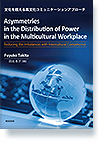検索結果一覧
Asymmetries in the Distribution of Power in the Multicultural Workplace :Reducing the Imbalances with Intercultural Competence
本商品はオンライン書店のプリントオンデマンドサービスで購入可能です。 ご注文はネット書店:Amazon、三省堂書店*(楽天市場店・PayPayモール店)、楽天ブックスへ直接お願いいたします。なお、価格は希望小売価格です。販売価格が変動する場合がございます。*要送料・PayPayモール店は製本形態が異なります。


- 田北冬子



- A5

- 216

- 2,200円 (本体2,000円 )

- 2020年3月30日

- ISBN978-4-86327-517-1

- C3082

- 教育

- Cross-Cultural Communication Strategy-Language and Power/ Issues of English as a Lingua Franca (ELF)/ Developing Intercultural Competence/ Power Relations and Interactional Dominance/ Implications for Balancing Power Relations in the Multicultural Workplace(本文英文)
In the U.S., UK, Canada, France, Spain, Italy, Germany, you can order this book through Amazon at your country.
| オンライン書店で購入する |
|
|---|---|
| 渓水社で購入する |
【取扱い不可】 |

- Abstract
Table of contents
Abbreviation Used in This Study
Acknowledgements
Chapter 1 Introduction
1.1 Background
1.2 Power Relations in the Workplace Across Culture
1.3 Problem of English as Dominant Language
1.4 Ideology and Power
1.5 Goal of the Research Project
1.6 Dissertation Overview
Chapter 2 Literature Review
2.1 Introduction
2.2 Language and Power
2.3 Issues of English as a Lingua Franca (ELF)
2.4 Conversational Styles and Dominance
2.5 Problems of NNS and NS Interaction
2.6 Strategic Competence and Communication Strategies
2.6.1 Theory by Canale and Swain
2.6.2 Bachman’s model
2.6.3 Taxonomy of CSs of Tarone’s
2.6.4 Definition and Taxonomy of CS by Færch and Kasper
2.6.5 The Nijmegen project
2.6.6 Issues and limitations of previous CS research
2.7 Developing Intercultural Competence
Chapter 3 Pilot Study
3.1 Introduction
3.2 Research Questions
3.3 Methodology
3.4 Results
3.4.1 Silence
3.4.2 Talk Distribution
3.4.3 Questioning Strategies
3.4.4 Directness/Indirectness Strategies
3.4.5 Survey of Japanese Observers’ Perceptions
3.5 Discussion
Chapter 4 This Study
4.1 Introduction
4.2 Research Questions of This Study
4.3 Data Collection Methods
4.3.1 Participan
4.3.2 Data Collection Procedure
4.3.3 Ethnographic Descriptions of the Meeting
4.3.4 Data Analysis of the Meetings
4.4 Interview Data Analysis
Chapter 5 Power Relations and Interactional Dominance in Department Meetings
5.1 Introduction
5.2 Distribution of Interactional Dominance
5.3 IRF (Initiation, Response, and Follow-ups) as Indication of Dominance
5.4 Interruptions as Indication of Dominance
5.5 Types of IRF and Interactional Patterns of Dominance
5.6 Intercultural Competence in Meeting Interaction
5.7 Intercultural Communication Strategies in the Meetings
Chapter 6 Conflicting Perceptions of Power Relations and Professional Accumulation
6.1 Themes Identified and Participants’ Perceptions of Power Relations
6.2 Conflicting and Shared Perceptions of Power Relations in the Meetings
6.3 Acculturation and Construction of Professional Identity
6.4 Development of Intercultural Competence
6.5 Comparison between Meeting Interaction and Reported Perceptions
6.6 Conclusion
Chapter 7 Conclusion
7.1 Summary of Findings
7.2 Implications for Balancing Power Relations in the Multicultural Workplace
7.2.1 Need to Create an Inclusive Work Environment for More Equal Power Relations
7.2.2 Recognizing English as a Dominant Language Creating Unequal Power Relations
7.2.3 Learning to Use English as a Lingua Franca (ELF) and an International Language (EIL)
7.2.4 Employing Some Effective Communication Strategies Collaboratively to Balance Power Relations
7.2.5 Adapting to Different Cultural Communication Styles
7.2.6 Importance of Being Aware of Our Own ‘Ideologies’ across Culture
7.2.7 Mutual Efforts for Adaptation and Developing Intercultural Competence
7.3 Significance of This Study
7.4 Limitations of This Study
7.5 Future Research
References
Appendices
Appendix 1
Appendix 2
Appendix 3
Appendix 4
Appendix 5



